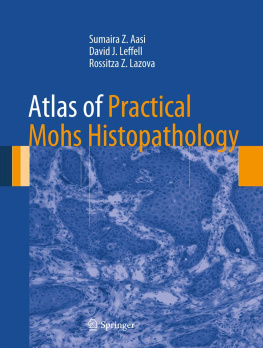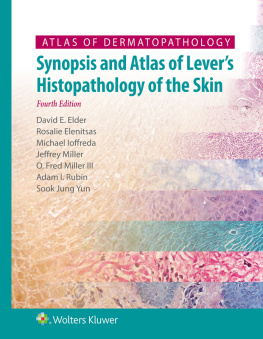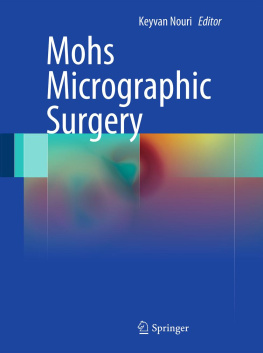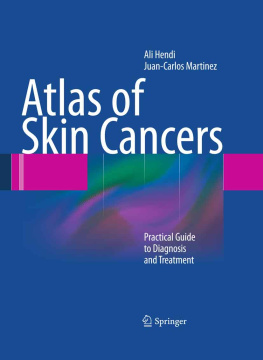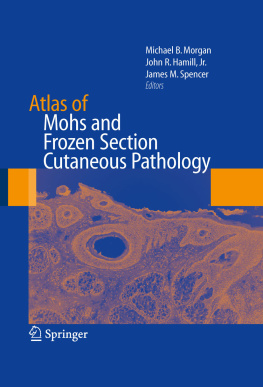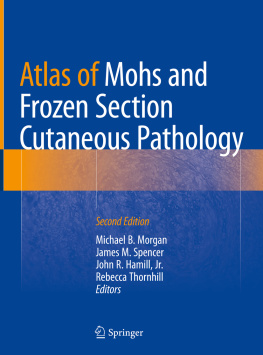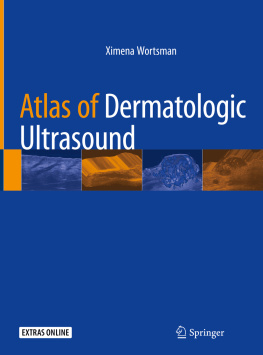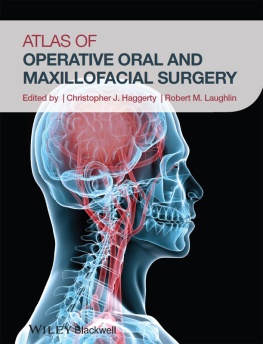Sumaira Z. Aasi , David J. Leffell and Rossitza Z. Lazova Atlas of Practical Mohs Histopathology 2013 10.1007/978-1-4614-5161-7_1 Springer Science+Business Media New York 2013
1. How to Use This Atlas
Sumaira Z. Aasi 1, David J. Leffell 2 and Rossitza Z. Lazova 3
(1)
Stanford University School of Medicine, 450 Broadway Street Pavilion B, 4th Floor, Redwood City, CA 94063, USA
(2)
Yale School of Medicine, 40 Temple Street 5th Floor, Suite 5A, New Haven, CT 06510, USA
(3)
Yale School of Medicine, 15 York Street, New haven, CT 06519, USA
Abstract
The incidence of skin cancer continues to rise and with it there is an increasing focus on the need to treat malignant skin tumors in an effective and cost-efficient fashion. Mohs surgery, more specifically referred to as Mohs microscopically controlled surgery, is a tissue sparing method for the stepwise removal of skin cancer. The approach, performed in the office setting under local anesthesia, permits maximal normal tissue preservation while optimizing the cure rate. It is the treatment of choice for a variety of skin cancers on the face, head and neck, trunk and extremities. Originally developed at the University of Wisconsin by Frederick Mohs, the method used a fixed tissue approach through the application of zinc chloride. In the early 1970s, this method gave rise to the frozen section Mohs technique. This book focuses exclusively on the frozen section method . We do not discuss special stains and limit our discussion to hematoxylin and eosin - stained tissue . While some Mohs surgeons may use other methods, in order to make this text applicable most broadly we have focused on the most commonly used method of tissue preparation. Ultimately, as the reader will see, Mohs histopathology is much more about pattern recognition and understanding cellular features than about the particular stain that is used.
The incidence of skin cancer continues to rise and with it there is an increasing focus on the need to treat malignant skin tumors in an effective and cost-efficient fashion. Mohs surgery, more specifically referred to as Mohs microscopically controlled surgery, is a tissue sparing method for the stepwise removal of skin cancer. The approach, performed in the office setting under local anesthesia, permits maximal normal tissue preservation while optimizing the cure rate. It is the treatment of choice for a variety of skin cancers on the face, head and neck, trunk and extremities. Originally developed at the University of Wisconsin by Frederick Mohs, the method used a fixed tissue approach through the application of zinc chloride. In the early 1970s, this method gave rise to the frozen section Mohs technique. This book focuses exclusively on the frozen section method . We do not discuss special stains and limit our discussion to hematoxylin and eosin - stained tissue . While some Mohs surgeons may use other methods, in order to make this text applicable most broadly we have focused on the most commonly used method of tissue preparation. Ultimately, as the reader will see, Mohs histopathology is much more about pattern recognition and understanding cellular features than about the particular stain that is used.
A critical element of the Mohs technique is that the properly trained Mohs surgeon is also the individual who maps, oversees the processing of, and interprets the specimen. This reduces the chance for error in tumor mapping and is probably a key element in the high cure rate observed with the technique. To this end, of course, the ability to interpret specimens is paramount. It is not possible to perform Mohs surgery properly without adequate training in the interpretation of Mohs frozen section histopathology slides. This atlas is intended as an aid to slide interpretation. We have specifically focused on normal skin as a foundation and have highlighted common variations of abnormal in each of the disease categories normally treated by Mohs surgery. Use of this text presumes knowledge of dermatopathology. That is, the terminology assumes proper exposure to skin pathology whether through dermatology, pathology, or other specialty training. This is not an introductory level text nor is it a how-to manual. Interpreting Mohs histopathology slides is both an art and a science. The distinction of cancerous tissue from non-cancerous tissue is not always clear-cut, nor always absolute, even among similarly trained colleagues within the subspecialty. There is nuance in interpretation of the cells as well as the various patterns of cellular alignment that are informative for the diagnosis of cutaneous malignancies. Rather, this text is intended to serve as an adjunct for people who have pursued formal training in Mohs surgery or dermatopathology. We hope this atlas will serve as an effective aid in addressing both routine Mohs surgery cases and clinical-pathologic conundrums that arise. To be certain, the range of complexities in a given case, such as a spindle cell carcinoma, can be vast. There are ancillary studies such as immunohistochemistry that can often help clarify obtuse cases. Such discussion is beyond the scope of this text. However, the common points of confusion, from the point of view of differential diagnosis, are specifically addressed in many of the chapters where the potentially confusing entities are compared feature by feature. While not to be used as a checklist, this structure will help organize your thinking as you approach challenging cases. More specifically what distinguishes this atlas and perhaps makes it most clinically relevant for the Mohs surgeon is that it discusses the false negatives and false positives that form the basis of the inevitable question that a Mohs surgeon faces at each moment, with each case and each stage: Is this cancer or not, do I excise more or not? By comparing and contrasting normal or benign histologic findings, studying challenging cases from low to high magnification in different sections and deeper cuts into the specimen, the atlas will uniquely allow the reader to appreciate the rationale when no absolute answers exist and develop the skills to make such decisions when faced with their own clinical conundrums.
We hope that the extensive effort invested in producing the highest quality rendition of actual Mohs histopathology specimens will provide you with the level of image detail you require to make the greatest use of this text.
Sumaira Z. Aasi , David J. Leffell and Rossitza Z. Lazova Atlas of Practical Mohs Histopathology 2013 10.1007/978-1-4614-5161-7_2 Springer Science+Business Media New York 2013
2. Normal Skin
Sumaira Z. Aasi 1, David J. Leffell 2 and Rossitza Z. Lazova 3
(1)
Stanford University School of Medicine, 450 Broadway Street Pavilion B, 4th Floor, Redwood City, CA 94063, USA
(2)
Yale School of Medicine, 40 Temple Street 5th Floor, Suite 5A, New Haven, CT 06510, USA
(3)
Yale School of Medicine, 15 York Street, New haven, CT 06519, USA
Abstract
The skin is generally considered to consist of three major layers: epidermis, underlying dermis, and subcutaneous fat. Depending on anatomic site, there are four to five layers of the epidermis. The layer closest to the basement membrane is the stratum basalis (or basal layer), which consists of a single layer of cuboidal cells that have a slightly basophilic cytoplasm and high nucleus to cytoplasm ratio. The stratum spinosum (or spinous layer) is above the stratum basalis and is so-called because of the prominent intercellular connections. The stratum granulosum (or granular layer) consists of flattened cells that contain coarse, basophilic granules. The stratum corneum (keratinous layer) is most superficial and consists of anucleate cells arranged in a basketweave pattern. On acral skin an additional layer called stratum lucidum is also present. The dermis consists of papillary dermis, consisting of a fine network of collagen and elastic fibers located immediately beneath the epidermis, and reticular dermis, which consists of thicker dense collagen bundles and extends to the subcutaneous fat. The thickness of the epidermis and dermis varies depending on the region of the body. Finally, the subcutis is composed of lobules of adipocytes separated by fibrous septae. Within the septae are blood vessels, lymphatics, and nerves.

